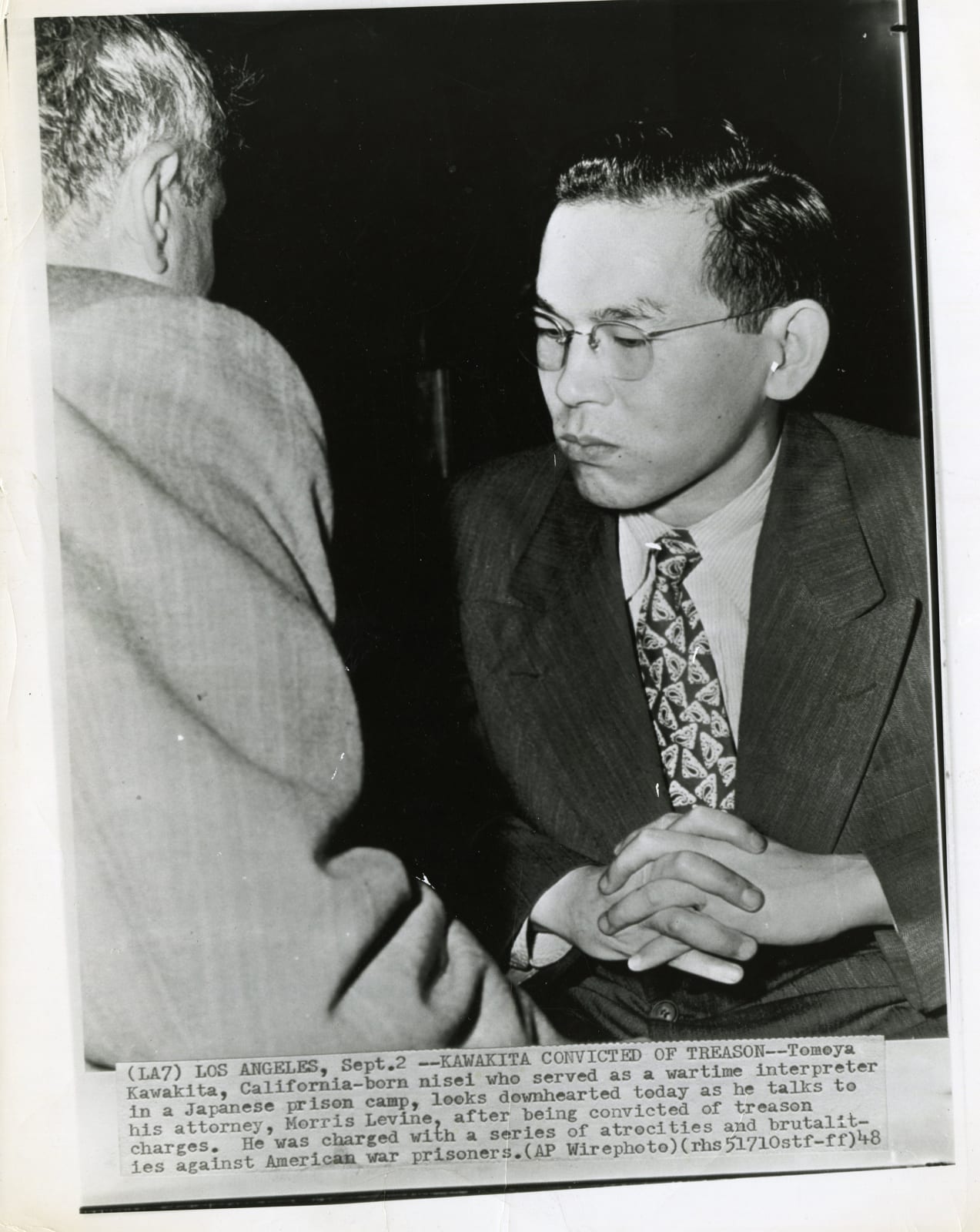Unknown (Various Press Agencies)
Photographs of Tomoya "Meatball" Kawakita, an alleged "War Criminal," convicted of treason for acts committed in Japan during WWII, c. 1950
Silver prints (16)
6 x 8 to 8 x 10 inches
With Press notations, dates, and snipes verso.
With Press notations, dates, and snipes verso.
Further images
This rare collection of photos documents the compelling and complicated court case of Tomoya Kawakita, one of two Nisei (2nd generation Japanese-Americans) convicted of treason for collaborating with the Japanese...
This rare collection of photos documents the compelling and complicated court case of Tomoya Kawakita, one of two Nisei (2nd generation Japanese-Americans) convicted of treason for collaborating with the Japanese during WWII.
Born in Calexico, CA, Kawakita traveled to Japan with his father in 1939, when he was eighteen years old. Though his father returned home. Kawakita stayed to study at Meiji University. His family believed if Kawakita studied in Japan and became fluent in the language, he could find success in the US with the Japanese import business. According to his biography in the Densho Encyclopedia, after the war broke out:
“Kawakita entered his name into his family's koseki , or family register, to assure him rights of Japanese citizenship and to secure employment...In August 1943, Kawakita began work as an interpreter at the Oeyama Nickel Industry Company, Ltd., a mining and metal processing plant located sixty miles from Kyoto near the Sea of Japan. During the war the company used Allied prisoners of war as laborers. Kawakita interpreted between the Japanese military foreman in charge of the adjoining POW camp and the prisoners, who included Britons, Canadians, Chinese and—after late 1944 and early 1945—about four hundred American POWs, most of whom had been captured on Bataan in 1942.”
After the war ended, Kawakita served the American forces as an interpreter before going to Tokyo with the intention of returning home. In December 1945, he applied for a renewal of his U.S. passport at the U.S. consulate, where he explained his Japanese citizenship by asserting that he registered in his family's koseki only in 1943 and under severe pressure. He returned home and enrolled at USC but in October of 1946 William L. Bruce, a former POW, spotted him at a Sears Roebuck store in Los Angeles. Bruce reported this to the FBI and in June of 1947 Kawakita was arrested and charged with 15 counts of treason.
At his trial, Kawakita pleaded not guilty and his defense rested on the status of his citizenship. His lawyer, Morris Lavine, argued that Kawakita saw himself to be a Japanese citizen with no allegiance to the US, who had renounced him as a citizen. But this argument was rejected by the courts (including the Supreme Court), which ruled that he had retained his US citizenship during the war. Originally sentenced to death, Kawakita's sentence was commuted to life imprisonment, and he was eventually released from prison, deported to Japan, and barred from ever returning to the United States.
Born in Calexico, CA, Kawakita traveled to Japan with his father in 1939, when he was eighteen years old. Though his father returned home. Kawakita stayed to study at Meiji University. His family believed if Kawakita studied in Japan and became fluent in the language, he could find success in the US with the Japanese import business. According to his biography in the Densho Encyclopedia, after the war broke out:
“Kawakita entered his name into his family's koseki , or family register, to assure him rights of Japanese citizenship and to secure employment...In August 1943, Kawakita began work as an interpreter at the Oeyama Nickel Industry Company, Ltd., a mining and metal processing plant located sixty miles from Kyoto near the Sea of Japan. During the war the company used Allied prisoners of war as laborers. Kawakita interpreted between the Japanese military foreman in charge of the adjoining POW camp and the prisoners, who included Britons, Canadians, Chinese and—after late 1944 and early 1945—about four hundred American POWs, most of whom had been captured on Bataan in 1942.”
After the war ended, Kawakita served the American forces as an interpreter before going to Tokyo with the intention of returning home. In December 1945, he applied for a renewal of his U.S. passport at the U.S. consulate, where he explained his Japanese citizenship by asserting that he registered in his family's koseki only in 1943 and under severe pressure. He returned home and enrolled at USC but in October of 1946 William L. Bruce, a former POW, spotted him at a Sears Roebuck store in Los Angeles. Bruce reported this to the FBI and in June of 1947 Kawakita was arrested and charged with 15 counts of treason.
At his trial, Kawakita pleaded not guilty and his defense rested on the status of his citizenship. His lawyer, Morris Lavine, argued that Kawakita saw himself to be a Japanese citizen with no allegiance to the US, who had renounced him as a citizen. But this argument was rejected by the courts (including the Supreme Court), which ruled that he had retained his US citizenship during the war. Originally sentenced to death, Kawakita's sentence was commuted to life imprisonment, and he was eventually released from prison, deported to Japan, and barred from ever returning to the United States.











